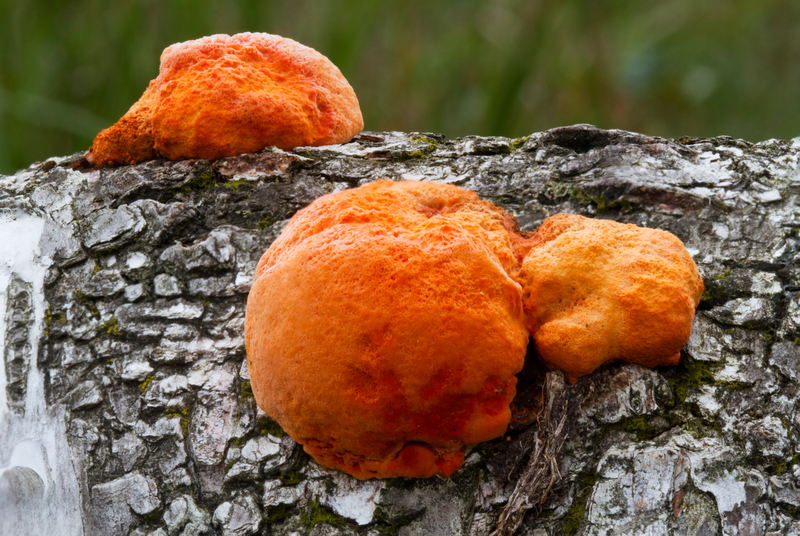If you've never thought of using mushrooms for anything besides enhancing your favorite dish, here are a couple of surprising ways they can be used. We had no idea they worked for these purposes!
Fire-Starting with Fungus
As already mentioned, mushrooms can be very good for “catching the spark” when starting fire with flint or maintaining the ember when starting with the bow drill and the like. A nice dry piece of Polypore can be used in the middle of your tinder bundle. Species with a felting interior, like the Tinder Polypore, can be fluffed into very nice tinder by scraping them with your knife to tease the fibers into fluff. While it can obviously be very helpful to have nice downy tinder, it is not always necessary as even chunks of dried Polypore can stay lit with just a spark.Transferring a “coal” from bow or hand drill methods is simply done by contacting the mushroom with the ember so that it keeps lit. One might even use larger flat polypores underneath the fireboard so that the hot wood dust falls directly on the mushroom.
Polypores are like punk, meaning that they stay lit easy. Punky wood (dry and rotten) might very well stay lit for hours from only a spark or ember, but generally wood requires sufficient heat to keep burning or it goes out. Polypores can stay lit for many hours, often slowly burning from just a small ember until all the mushroom is burned up. This has several uses. Such as in primitive times, lit Polypores can be bound in leaves and bark so that the fire could be carried to the next spot. I have also maintained embers in the firepit by setting in them a piece of Polypore during times when I did not desire to build up the fire by adding more wood. Obviously, the standard rule is to keep watch on a fire at all times, but we are talking survival here. Perhaps, you are lost in the woods with no fire-starting implements and need to spend the day hunting, fishing, or gathering mushrooms. You certainly don’t want to lose your fire, but you don’t want to build it up either right before leaving. It could be much safer to feed the embers with mushrooms than to pile on firewood.
Mushrooms don’t have the tendency to burst into flame, even though they stay lit well. In order to produce flame, hot pitch can be poured on the Polypore and then lit to produce a torch. Alternately, clumps of pitch can be set or stuck (depending on consistency) on a Polypore and then lit. The pitch will melt down into the mushroom and this makes good fuel.
Polypores can also be made into charcoal in the same manner as making char cloth. I have used the leathery Polypores, like Turkey Tail, as well as slices of thicker species like Tinder Polypore and Reishi. I usually use tins, such as old Altoids tins, to fill with the mushrooms and then place on the hot coals until smoking ceases. Then remove, let cool, and add to your tinder box for later fire-starting.
Fiber from Polypores
Polypore can be made into felt. This can be done by boiling and pounding the interior portion (which looks felty even when fresh). A friend of mine has hats made of the felt, similar to that worn by the famous mycologist Paul Stamets. I have also seen purses and other crafts from the felt. It might be a stretch to consider making an outfit out of Tinder Polypores in a survival scenario. Small pouches and such, on the other hand, could be very realistic and handy.At the New Jersey Mycological Association’s yearly Fungus Fest they set up a paper-making station. Violet Tooth Polypores (Trichaptum biforme) and other similar mushrooms are blended in water in order to produce a fibrous mush that is strained, pressed, and dried to produce a sturdy craft paper. Violet Tooth Polypores work well for fiber extraction because they are thin, like the well-known medicinal Turkey Tail and other mushrooms that comprise the “leathery” group of Polypores.
Taking Care of Tools with Polypores
Pieces of dried Polypores can work great for storing fish hooks. I like to slice the fresh mushroom into thick strips before drying them. This makes them handy for decocting into medicine, for stashing in tinder boxes, and for piercing a selection of fish hooks into in attempt to keep a tackle box orderly. It also makes them ready for making charcoal if, for instance, they are cut so that they fit into an Altoids box or some other vessel that can be used to make charcoal. Have a line-up of fish hooks in a small rectangle of Polypore makes it easy to grab a few hooks to throw in your pocket or in your sack. If it keeps dry, you’ll even have fire-starting material with you. If it gets wet, just toss it – you have plenty more stashed away.Apparently Birch Polypore can be used for stropping. An alternate name commonly cited for the Birch Polypore (Piptoporus betulinus) is Razor Strop. I have never tried it, but the dried fruiting bodies certainly seem to be the correct consistency (usually leather is used for stropping).
Have you ever used any of these mushrooms? What did you use them for? Would you consider using mushrooms to start a fire or to make fiber? Share your thoughts in the comment section below!
Article Source: Survival Cache

Chris Whitten
They start fires and keep the Bears away
Jerri Wheatley thought u might like this one
Interesting. Thanks for thinking of me. Xoxo
Tami
The resin in some mushrooms can be used to waterproof items like clothes or tents
Pele
Good ideas!